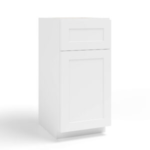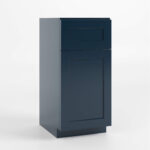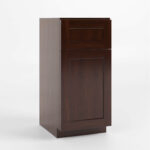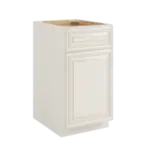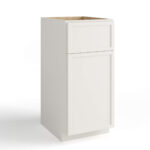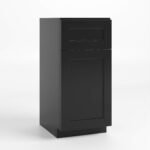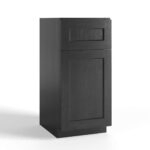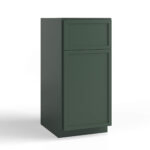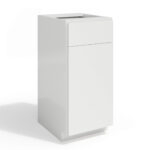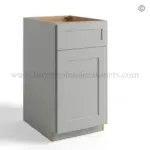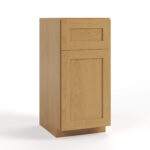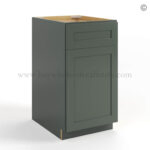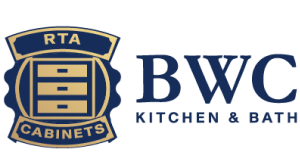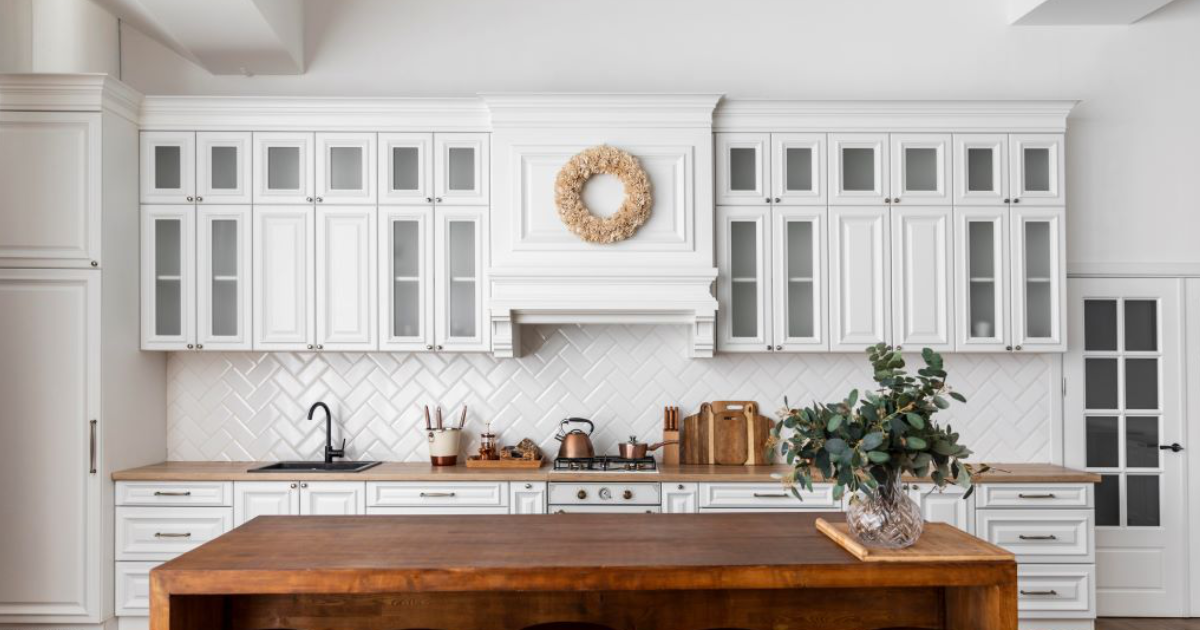Table of Contents
A kitchen island is often known as just a countertop. However, it is quite literally the beating heart of a kitchen. It is a central spot for cooking, eating, and gathering. That said, constructing one from scratch can be overwhelming. It tends to be a time-consuming and expensive process. This is where RTA (Ready-to-Assemble) kitchen island cabinets are so handy.
Island cabinets offer style and functionality. A smart solution for homeowners, these cabinets are also an economical option. They are affordable, flexible, and easy to assemble. They suit any kitchen layout. From a modern, minimalist kitchen island to a cozy farmhouse look, island base cabinets can beautifully adapt to your space.
Exploring the types of cabinets best suited for islands helps homeowners understand the island design ideas that work for kitchens of all sizes. Let’s learn more about some practical installation tips. In this post, you can find answers to common questions and learn how to ensure your projects go smoothly. Read on to know just how to choose and set up an RTA kitchen island with great looks and superb functionality.
What Is an RTA Kitchen Island?
RTA stands for Ready-to-Assemble. These cabinets come flat-packed and are designed for easy DIY assembly. They’re like high-quality stock cabinets, but built to last and designed for custom kitchen island applications.
One significant benefit is cost. Skipping professional installation saves money, and transporting them is simple because they come in compact boxes. Island base cabinets in RTA format are particularly cost-effective for creating storage space.
Another plus is flexibility. RTA islands often let you mix and match modules, so you can design your space’s storage layout. Installing one is straightforward, even for beginners. Basic tools can turn an empty corner into a functional centerpiece in a few hours for contemporary kitchens.
Island cabinets also let you experiment with island design. Add open shelving, choose bold hardware, or swap finishes. You can get a stylish, practical kitchen island without hiring a contractor, making it perfect for new island projects.
Benefits of Using RTA Cabinets for a Kitchen Island
The kitchen island is the centerpiece of the kitchen. It provides extra storage space for meal preparation. It is also wonderful as a casual dining area. The island also helps shape the flow of the kitchen layout. So the type of base cabinets you opt for matters. Island base cabinets score high compared to traditional custom cabinets for the following reasons.
The first benefit most people notice is cost. Island base cabinets are cost-beneficial compared to custom-built cabinets. They are pre-manufactured units that can be fitted together quickly. On the other hand, traditional or standard built-in perimeter cabinets are usually expensive and require professional assistance for installation.
The next benefit is that island base cabinets are a flexible alternative. They can also be adjusted to fit the layout. They can match your kitchen’s workflow. Since these cabinets are modular, you can mix pieces to create a kitchen island that best suits your needs. Consider your requirements. Add more drawers on one side and shelves on the other for storage solutions.
Another strong point is the variety of styles. Regardless of your preferences, there’s something to match your island design taste. You can get a modern slab front, a deep espresso finish, or even pristine white cabinet doors. The available options make it easy to match with your existing perimeter cabinets. Choose from a selection of hardware, colors, and finish options.
Durability is a worthwhile consideration for any kitchen island. With budget-friendly options, this aspect is often a concern. Many island base cabinets use plywood or solid wood construction with quality hardware. They are designed to withstand daily use. They also do not wear out too quickly. Thus, they are ideal for food prep areas.
A final advantage is that RTA cabinets are easy to upgrade or replace. You can swap out cabinet doors, hardware, or even entire sections. This is an exceptional way to update your kitchen island. Thus, there is no need to start from scratch to refresh its look.
Types of Cabinets You Can Use for an RTA Kitchen Island
One of the best parts of using island base cabinets is their versatility. RTA islands are also a delight, as you can use various combinations for cabinet types. They each have their own purpose. You can create a kitchen island to suit your style and storage needs. You can mix and match base cabinets to achieve the desired outcome. Mentioned below are some cabinet options to consider to shape how your kitchen island looks and works:
Base Cabinets for Maximum Storage
Base cabinets do the heavy lifting for any kitchen island. They are best for pots, pans, and small appliances. Do not forget to consider your seating needs. The backbone of most kitchen island designs, these island base cabinets help avoid clutter on the counter space. You can get roomy storage space options by installing base cabinets on both sides of the kitchen island. Their depth also makes them ideal for bulkier kitchen essentials, providing storage solutions that perimeter cabinets can’t match.
Drawer Cabinets for Easy Organization
Drawer cabinets make life easier for any kitchen island. They are great for utensils and small gadgets for meal prep. You can organize them neatly. So no more haphazard stacking. So remember storage needs before choosing island base cabinets for a kitchen island is essential. Use small drawers for silverware and kitchen tools. Wide drawers are ideal for skillets or cutting boards. For a quiet finish, add soft-close features to your island’s base.
Open-Shelf Cabinets for a Modern Look
Open-shelf cabinets are preferred for their lighter feel in contemporary kitchens. You can store and display your favorite cookbooks. Place your spice racks. Set some multicolored ceramics. Or display baskets with daily-use items on open shelving. Plus, they make grabbing things quick with easy access. Just keep in mind that whatever you put on display needs to stay somewhat tidy since it’s always visible on your kitchen island.
Specialty Cabinets for Custom Features (Wine Racks, Microwave Cabinets, Pull-Outs)
Island base cabinets can be customized for your custom kitchen island. Specialty options add personality to your kitchen island, including different finishes, hardware, or shelving options. Wine racks create a built-in spot for bottles. Pull-out trash or recycling bins keep things hidden and clean. You can save counter space with microwave cabinets. You can also blend appliances into the island design. These extras transform your kitchen island from “just storage” into a true multitasking centerpiece for contemporary kitchens.
How to Choose the Right Size and Layout for Your Island
A kitchen island design is not just about adding more storage space. It also includes considering the size and layout. It even impacts how your kitchen feels and functions. A poorly sized kitchen island can make movement awkward or crowd your workspace, especially in relation to wall cabinets and perimeter cabinets.
Measuring Your Kitchen Space
It is vital to start by measuring your kitchen floor. Note the length and width of your space. It is best to leave at least 36 inches around all sides of the kitchen island to have room for traffic. Thus, it makes cooking or entertaining guests comfortable. Also, measuring the ceiling height is essential to add pendant lights or overhead storage that works with your upper cabinets.
Matching Your Cabinets to Island Size
Island base cabinets must be proportionate and harmonious with your kitchen island. If the kitchen island is too bulky or tall, it will dominate the room. If the base cabinets are too small, they may look tacky. Base cabinets, drawers, and specialty units must suit your space. The kitchen island must be equally functional and visually appealing. Also, do not forget to keep in mind the intended use of the island’s base and what you’ll store on the kitchen island.
Ensuring Proper Workflow & Clearance
The stove, sink, and refrigerator should form an efficient path around your kitchen island. Make sure the kitchen island doesn’t block this triangle. Island base cabinets can also be adjusted to fit the layout and match your kitchen’s workflow. They move well into tight spaces without much hassle. Thus, leave enough legroom if your kitchen island doubles as bar style seating for entertaining guests.
Design Ideas for RTA Kitchen Island Cabinets
Kitchen island ideas can be wonderful for creative souls. Make small switches for better results. You can refresh the space with bold changes or subtle additions. Have fun with island cabinets’ colors, finishes, and little details. Make the kitchen island the main feature to give it a unique island design personality.
Mixing Colors and Finishes
A blend of colors and finishes looks stunning. It enhances the visual interest of the kitchen. Putting together dark island base cabinets with lighter stone countertops or contrasting drawers can be striking. You could also opt to paint the island base against natural wood accents to make a noticeable difference that adds visual interest.
Adding Decorative Panels and Trim
Adding decorative panels or crown molding is an excellent way to customize an RTA kitchen island. A simple trim along the edges or on cabinet doors adds depth. These relatively small touches can lend the kitchen island a finished and polished look, making your new island feel custom-built.
Two-Tone Island Cabinets
Two-tone islands are trending, and rightly so! A darker island base paired with lighter wall cabinets is the top choice of many for contemporary kitchens. This visually anchors the kitchen and creates a focal point for your kitchen island. So, the room looks well-thought-out. Additionally, you can balance out the cabinetry with the open space.
Matching Island Cabinets with Wall Cabinets
Cohesion matters for any kitchen island, so does matching styles, lines, and materials. This helps to create a harmonious look. Wall cabinets in a subtle color can unite all elements of the space. Remember, your kitchen island must complement and not compete with your kitchen. The island serves best when it works with existing perimeter cabinets.
Tips for Installing RTA Cabinets on a Kitchen Island
Installing an RTA kitchen island may initially seem intimidating. But it’s easier than most expect. The key is patience, not speed. So don’t rush through the setup. With the right approach, it can become a weekend project. It can also become your kitchen’s functional centerpiece. And remember, once it’s done, you’ll enjoy the payoff every single day in your kitchen with your new island.

Assembly and Installation Process
Start by unpacking all the island base cabinet pieces and checking the instructions. Lay everything out so you can see screws, brackets, and panels. Begin with base cabinets and connecting panels as shown in the manual. Using a level ensures island base cabinets sit flat on the kitchen floor. Tighten screws gradually rather than all at once to avoid misalignment. Take your time with your kitchen island assembly. Even small adjustments at this stage save headaches later.
Securing Cabinets Together for Stability
Once the island base cabinets are in place, they need to be connected securely to your kitchen island. Metal brackets and screws are typically included with RTA kits. Align cabinet edges carefully to maintain a flush appearance on the island’s base. A second set of hands helps keep everything steady. After securing brackets, double-check with a level to ensure the kitchen island sits straight. Stability matters, especially if the kitchen island will serve as a prep area or bar-style seating space.
Adding Countertops and Accessories
After the island base cabinets are assembled and secured, it’s time for the countertop material. Measure the kitchen island. Choose a material that complements your kitchen. Quartz, butcher block, and granite are popular choices for countertop material. Leave a slight countertop overhang. This is best if you plan to add barstools to make the seating comfortable. Install backsplash panels or decorative trim for a polished look. Don’t forget functional touches like handles, knobs, or pull-out trays. These small details make the kitchen island easier to use and give a finished feel to your custom island.
FAQs About RTA Island Cabinets
Can I use regular kitchen base cabinets for a kitchen island?
Yes, you can use kitchen cabinets for your kitchen island. Standard base cabinets work. But they must be sturdy and have enough clearance. However, they might require more effort to move and fit into the kitchen island layout. Island base cabinets, on the other hand, are designed for easy assembly and modular setups. This flexibility makes it simpler to customize the kitchen island for storage, seating, or appliances, creating the perfect island design.
Are drawer cabinets better than base cabinets for an island?
Drawers offer better organization for utensils, gadgets, and small cookware on any kitchen island. Base cabinets handle larger items like pots, pans, or small appliances. Drawers are best for everyday items. They provide easy access without digging through a deep cabinet. A common approach for island design is to mix both types. This gives you deep storage space where needed and easy access where it counts for meal preparation.
Do RTA island cabinets come with pre-drilled holes for assembly?
Most RTA island base cabinets include pre-drilled holes. They combine ease of assembly with durability for your kitchen island. These holes help keep everything aligned correctly and reduce the chance of mistakes. While the island cabinets are great for easy DIY setup, you’ll still need basic tools like a screwdriver or drill to secure panels and brackets. Taking your time to follow instructions ensures a sturdy, long-lasting kitchen island.
Can I add custom features like wine racks or pull-out trays to my RTA island?
Yes, specialty modules or add-ons can be incorporated into your kitchen island. Modular RTA systems make wine racks, pull-out trays, and microwave cabinets possible for your island design. Planning the layout before assembly helps ensure everything fits perfectly. You can also mix in drawers, shelves, and open sections for maximum functionality. These custom touches let you adapt the kitchen island to how you actually use your kitchen. Thus, the finished look is both functional and stylish, creating a huge island impact without the custom island cost.
How do I choose the right size cabinets for my kitchen island?
Measure available space carefully for your kitchen island. Remember to leave at least 36 inches around the kitchen island for clearance. Storage space needs and intended use must be considered. Also, do not forget how you’ll use the kitchen island. Plan a mix of drawers, shelves, and specialty cabinets. The kitchen island should enhance workflow. It should not block it. Thus, spacing and proportions matter as much as storage solutions for your large island plans.
What countertop materials pair well with RTA kitchen islands?
Quartz, granite, butcher block, and laminate are fantastic choices for countertop material. These work well on any kitchen island. Consider maintenance and durability. But do not ignore style. If you plan to add bar-style seating, the countertop material must have a comfortable overhang. But if you want a solid, premium feel, add thicker countertops. Best to add ones with wood filler for extra support. You can even mix materials. A butcher block top can work with painted island base cabinets. This is superb for extra visual interest.
